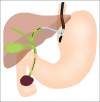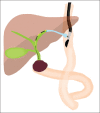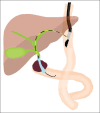How to perform EUS-guided biliary drainage
- PMID: 36255022
- PMCID: PMC9688140
- DOI: 10.4103/EUS-D-21-00188
How to perform EUS-guided biliary drainage
Abstract
EUS-guided biliary drainage (EUS-BD) has recently gained widespread acceptance as a minimally invasive alternative method for biliary drainage. Even in experienced endoscopy centers, ERCP may fail due to inaccessibility of the papillary region, altered anatomy (particularly postsurgical alterations), papillary obstruction, or neoplastic gastric outlet obstruction. Biliary cannulation fails at first attempt in 5%-10% of cases even in the absence of these factors. In such cases, alternative options for biliary drainage must be provided since biliary obstruction is responsible for poor quality of life and even reduced survival, particularly due to septic cholangitis. The standard of care in many centers remains percutaneous transhepatic biliary drainage (PTBD). However, despite the high technical success rate with experienced operators, the percutaneous approach is more invasive and associated with poor quality of life. PTBD may result in long-term external catheters for biliary drainage and carry the risk of serious adverse events (SAEs) in up to 10% of patients, including bile leaks, hemorrhage, and sepsis. PTBD following a failed ERCP also requires scheduling a second procedure, resulting in prolonged hospital stay and additional costs. EUS-BD may overcome many of these limitations and offer some distinct advantages in accessing the biliary tree. Current data suggest that EUS-BD is safe and effective when performed by experts, although SAEs have been also reported. Despite the high number of clinical reports and case series, high-quality comparative studies are still lacking. The purpose of this article is to report on the current status of this procedure and to discuss the tools and techniques for EUS-BD in different clinical scenarios.
Keywords: ERCP; EUS; EUS-guided biliary drainage; EUS-guided gallbladder drainage; acute cholecystitis; obstructive jaundice.
Conflict of interest statement
None
Figures












References
-
- Bang JY, Arnoletti JP, Holt BA, et al. An endoscopic transluminal approach, compared with minimally invasive surgery, reduces complications and costs for patients with necrotizing pancreatitis. Gastroenterology. 2019;156:1027–40.e3. - PubMed
-
- van Brunschot S, van Grinsven J, van Santvoort HC, et al. Endoscopic or surgical step-up approach for infected necrotising pancreatitis: A multicentre randomised trial. Lancet. 2018;391:51–8. - PubMed
-
- Fusaroli P, Jenssen C, Hocke M, et al. EFSUMB guidelines on interventional ultrasound (INVUS), Part V – EUS-guided therapeutic interventions (short version) Ultraschall Med. 2016;37:412–20. - PubMed
-
- Ryou M, Benias PC, Kumbhari V. Initial clinical experience of a steerable access device for EUS-guided biliary drainage. Gastrointest Endosc. 2020;91:178–84. - PubMed

